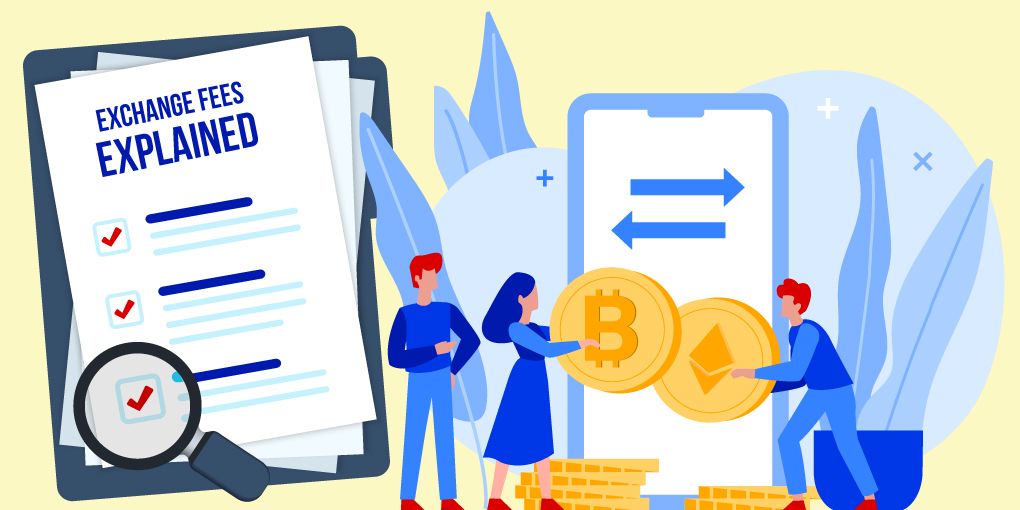Comparing fees on different crypto exchanges is your key to bigger gains. Think about it: every dollar saved on fees is a dollar added to your profit. Smart traders know this well. They search for the best deals, not just in prices but in fees too. And you, eager to grow your stash, must do the same. In this guide, I’ll dissect the fee structures that can eat into your returns. We’ll navigate the jungle of transaction costs, unravel the maker-taker model, and spotlight the crypto platforms that promise the most bang for your buck. Keep reading to sharpen your trading edge and keep more coins in your digital wallet.
Understanding the Landscape of Cryptocurrency Exchange Fees
Transaction Costs on Crypto Platforms
Let’s get real about the cash you give up when you trade crypto. Think of it like a store. Just stepping in costs you, that’s your transaction fee. Every crypto platform has them, but they’re not all alike. Some charge you percentages, others have a set price per trade.
When you swap Bitcoin on Coinbase, they’ll charge you. How much? It can change and it often depends on how many trades you make. So, more trading can mean you pay less per trade. Want to pay less? Some apps let you trade without fees. But watch out, they may get you with other charges.
Moving your coins off an exchange, like taking cash out of a bank. Kraken, for example, has a fee for this, called a withdrawal charge. Every platform is different. Some give you a few freebies before they start charging. It’s smart to compare what they’ll take from you before you choose where to trade.
Maker-Taker Fees and Their Impact on Trading
Now, about maker-taker fees. You’re a maker when you set up a price and wait for someone to take it. You’re a taker if you jump on a price that’s already there. Makers often pay less in fees, and sometimes nothing at all. Takers usually pay more.
Look at Binance. They’ve got this system, and if you create trades, you could pay less. It rewards you for adding to their market, see? They want a busy market, so they make it cheaper for makers. Makes sense, right?
But say you’re eager and snatch up a deal right away. You’ll pay a bit extra as a taker. It’s not just Binance. Lots of places have fees like this. Some don’t, though. It pays to check and see how you can save.
Gemini, Bitfinex, they all have their own fee schedules. It’ll take some homework to find the lowest fee crypto exchanges. Everyone says they’re the cheapest, but you’ve got to look at the fine print. And remember, lots of trades can change the fees you pay. Stay sharp.
If you dig deeper, spot trading fees, crypto withdrawal limits, even security fees, they can all eat into your coins. And if you’re going big with margin or derivatives trading, know the costs. They can be high, but if you play it smart, you might find they’re worth it.
So there you have it. Trading crypto means dealing with fees. But with a little know-how, you can keep more coins in your pocket. Look at those fees, compare them, and find where you get the most bang for your buck. It’s your money. Make it work for you.
Analyzing Popular Exchange Fee Structures
Coinbase Fees for Buying and Selling Cryptocurrencies
If you want to trade cryptocurrencies, fees matter. Let’s kick things off with Coinbase. Known for its ease of use, Coinbase charges a fee for buying and selling. How much? That depends on the trade size. For small trades, there’s a fixed fee. It can range from $0.99 to $2.99. But as trades get bigger, a percentage fee kicks in.
For larger transactions, Coinbase charges by percentage. This means the more you trade, the more you pay. On the bright side, these fees can get lower. How? When you trade more, and I mean way more, you enter different fee levels. That’s a cool way to save on costs if you trade often.
Comparing Binance’s Trading Fee Structure to Competitors
Now, Binance is another giant in the room. It often has lower fees than Coinbase. Binance uses a maker-taker model. What’s that? When you set a trade that doesn’t fill right away, you’re a “maker.” You add to the market’s liquidity. For this, you get charged less. But if your trade fills immediately, you’re a “taker” and pay a bit more.
Binance’s basic fee for takers is 0.1%. Sweet deal, right? But hang on, it gets even better. If you hold Binance’s own coin or trade a ton, your fees shrink. In the world of trading fees, Binance is like a discount store. You want trade perks? They’ve got them.
And don’t forget, trading volume makes a difference. Trade more, pay less. It’s a winning combo for active traders.
But what about when you’re new? Binance might look complex. It’s packed with charts, options, and numbers. But don’t fret. I’ve found that once you get the hang of it, it’s a smooth sail. Plus, those low fees? They keep you sailing longer.
Comparing these two, Coinbase and Binance, isn’t apples to apples. You’ve got to think about how much you trade and if you’re in it for quick deals or the long haul. Each has its own ups and downs. Binance can be cheaper. But Coinbase is user-friendly, especially for new traders.
Remember, there’s more out there. Kraken, Bitfinex, Gemini, they all have different fees. Before jumping in, study their fee schedules. Look for withdrawal fees and deposit charges too. These can sneak up on you.
And always, always check for hidden costs. Some platforms seem cheap at first. Then you find add-ons like security fees or withdrawal limits. Not fun.
Seeking the lowest fee crypto exchanges gets exciting. I do this like a treasure hunt. The prize? More cash stays in your pocket after trades.
There’s so much more to tell you. I want you to nail this thing. But let’s keep it bite-sized for now. Watch those trade sizes. See where you can cut percentages. And always keep an eye out for those hidden treasures – small savings that add up when you trade smart.
Identifying Hidden Costs and Finding the Lowest Fee Crypto Exchanges
The Reality of Hidden Costs in Crypto Transactions
When you trade crypto, some costs aren’t easy to see. They’re called hidden costs. These include withdrawal limits, the impact of trading volume on fees, and network fees, especially for Ethereum and other altcoins. Understanding these costs is key to saving money.
For instance, two exchanges might have the same percentage fee per trade. But one could have higher withdrawal fees, making it more costly in the end. Or take Ethereum. Its network fees can vary a lot, so a low trading fee might not matter if you’re paying a lot to move your Ethereum.
Take Kraken withdrawal charges, for example. They might seem low, but add high-volume trading fees, and they’re not so cheap anymore. It’s crucial to look at how all fees add up to get the true cost.
Spotlight on Exchanges with the Most Cost-Effective Fee Schedules
Now let’s talk about the best deals for trading. You want exchanges with low costs, right? We’re talking low transaction costs on crypto platforms and fair withdrawal charges. There are exchanges known for low fees. Like Binance; its trading fee structure is competitive. And if you’re selling Bitcoin, Coinbase fees can be higher, so that’s key to remember.
Then there are the maker-taker fees. These can change based on whether you’re creating or taking away from market liquidity. Exchange policies on these can affect your bottom line. It pays to know who charges what.
Some platforms offer no-fee cryptocurrency trading for certain operations or up to a specific volume, enticing traders with the appeal of cost savings. On the other hand, deposit fees by exchange can sneak up on traders who aren’t vigilant.
Have you heard of Bitfinex trading expenses or the Gemini fee schedule? Each exchange has a different way of charging you. Some use a percentage fee per trade. Others have a more complicated system. Look for the lowest fee crypto exchanges by comparing their rules and fees.
The most cost-effective altcoin exchanges will balance low transaction fees with moderate withdrawal costs. And remember the fixed vs variable crypto fees. Fixed can be good if you trade a lot. Variable can work if you trade less.
Do you want the best value crypto exchange? Then pay attention to all types of fees – trading, withdrawal, and network. An exchange with a slightly higher trading fee but no withdrawal fee might be cheaper. And if you’re diving into margin trading crypto costs, be even more careful. Those fees can add up quickly.
So always read the fine print. It’s where your savings are hiding. And check out fee comparison BTC exchanges to see who charges less. A good rule? Count all your costs, then choose where to trade. Your wallet will thank you.
Navigating Fees for Advanced Trading Options
A Look at Margin and Derivatives Trading Costs
We know trading crypto can be thrilling. But it costs money, right? Let’s dive into what makes up these costs. Especially when we talk about playing on margin or dabbling in derivatives, we’re in for some extra fees.
First, margin trading. Here’s where you borrow money to trade more than you have. More potential profit, sure, but more risk and definitely more fees. When using margin, you’ll face interest on your loan and perhaps some extra transaction fees. These vary by exchange. Binance might charge you a different rate than what you’d find on Coinbase, for instance.
Now, for derivatives. Think futures and options. Costs here include the trading fee per contract and maybe some settlement fees when closing your position. Fees on derivatives can sneak up on you. Always check the fine print on the exchange’s fee schedule.
How High-Frequency Trading Strategies Influence Fees
Next up, let’s get into high-frequency trading (HFT). This is serious business. It’s all about speed, squeezing out profits from small price gaps. Those tiny fees per trade? They add up quick when you’re trading a lot and fast.
Exchanges like to reward volume, so they might offer lower fees for traders who move big bucks. They call this the “maker-taker” fee model. If you’re providing liquidity (a maker), you usually get lower fees. Take away liquidity (a taker), and you might pay more.
But be careful, even with volume discounts, the more you trade, the more fees you’ll face. This impacts your bottom line. Always weigh the cost against potential profits. It’s like choosing the best tool for the job – you need the right fit for your trading style.
Crypto trading charges comparison? It’s clear. Every exchange has a unique fee setup. Whether it’s Binance, Coinbase, or Kraken, they all have their own way of doing things. Some offer flat rates. Think fixed percentage per trade. Others are all about sliding scales based on your past 30-day trading volume.
For those hunting for deals, lowest fee crypto exchanges are the holy grail. Who doesn’t love saving money? But watch out for those hidden costs. No-fee cryptocurrency trading doesn’t always mean it’s free. Deposit fees or hefty withdrawal charges can surprise you.
And let’s not forget those pesky network fees for altcoins or Ethereum transaction fees comparison. They vary wildly and depend on the network’s congestion at the time of your trade. You could pay more for Ethereum than Litecoin depending on the day.
Always keep an eye out on the cryptocurrency exchange fees. Trading fee structure Binance or Coinbase fees for selling Bitcoin, for example, can make or break your trade’s success. Spot trading, margin calls, or moving your money out – Kraken withdrawal charges or Bitfinex trading expenses – they all matter.
Solid fee comparison BTC exchanges or looking for cost-effective altcoin exchanges, can sharpen your edge in this game. After all, it’s not just about making money, it’s about keeping it too. Understand the costs, and trade smarter. That’s how you maximize those crypto returns.
In this post, we dived into what it costs to buy and sell crypto. We looked at how exchanges charge for trades and how some fees depend on your role in the deal. Our chat about Coinbase showed you what to expect when you start. We also checked out how Binance stacks up against others.
We snagged a truth bomb about hidden fees. Remember, low fees can hide extras, so keep sharp! We shone a light on exchanges that really save you money. So now you know using cheap exchanges can make your cash last longer.
Our last point touched on big-deal trading costs. We learned that the more complex your trade, the more you might pay. If you trade a lot, you will see different fees.
To sum it up, smart traders need to know their fees. Cheap can be pricey if you’re not careful. Keep an eye out, pick the right place, and save your money! This advice can help you make the best moves in the crypto world.
Q&A :
#### How do I compare fees across different cryptocurrency exchanges?
When comparing fees on various cryptocurrency exchanges, consider the following: trading fees (maker/taker), deposit and withdrawal fees, and any tiered fee structures based on volume or account type. To compare, list the exchanges you're interested in and visit their fee schedules on their websites. Additionally, look for reviews or fee comparison tools online that consolidate this information for ease of comparison.
#### What types of fees should I look for when evaluating crypto exchanges?
Be cognizant of several types of fees: trading fees, which may be different for the market maker and taker; deposit and withdrawal fees, which vary based on payment method and currency; and potentially hidden fees like account maintenance or inactivity fees. Understanding each exchange's fee structure is critical to assessing the overall cost of trading.
#### Are higher fees on crypto exchanges indicative of better service or security?
Not necessarily. While some exchanges may charge higher fees to provide additional services or enhanced security, this is not a universal rule. It's essential to read reviews, check for regulatory compliance, and consider the platform's security measures in conjunction with the fee structure.
#### Can the fee structures on crypto exchanges change, and how can I stay updated?
Yes, fee structures on crypto exchanges can change over time due to shifts in the market, regulatory changes, or adjustments in the exchange's business model. Stay updated by regularly checking the exchange's official website, subscribing to their newsletter, following them on social media, or setting up alerts if the platform supports it.
#### Is it cheaper to trade on decentralized exchanges compared to traditional crypto exchanges?
Decentralized exchanges (DEXs) often have lower fees than traditional, centralized cryptocurrency exchanges because they operate without an intermediary. However, there are other costs to consider with DEXs, such as network fees and slippage, which can affect the total cost of a transaction.


